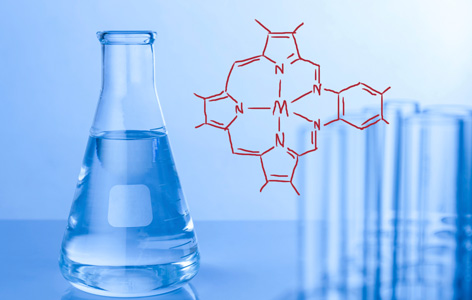Home page Description:
New nanoparticle is easy to make and can be used for multiple imaging methods in cancer.
Posted On: June 06, 2016

Image Caption:
The texaphyrin-based nanoparticle (texaphyrin structure sketched above) can be built in a single flask, an advantage for rapid and efficient manufacturing.
Small particles that can travel in the blood stream, accumulate in tumours, be imaged and help enhance therapies sound too good to be true, but those are the kind of nanoparticles that have been developed in the lab of Dr. Gang Zheng. Having had much success with developing applications for porphyrin-based nanoparticles, Dr. Zheng recently focused on a related molecule called texaphyrin.
Texaphryin can serve as a building block to create nanoparticles that strongly bind to metal. An important feature of the texaphryin-based nanoparticles being created by Dr. Zheng is that they can be customized to bind 17 different types of metals—a feature that provides them with a wide range of possible applications.
Another key advantage of texaphyrin-based nanoparticles is that they are easy to make. A single kind of texaphryin-based unit can be used to build completely functional nanoparticles. In fact, the research team was able to develop a “single pot” synthesis method, which means that there is no need to separate out and purify intermediate chemicals during the creation of the nanoparticle, greatly simplifying the creation of the nanoparticle and increasing its chances of commercial success.
As proof of principle, the research team developed one type of nanoparticle that could be used in cancer research. They incorporated a type of metal known as manganese into a texaphyrin nanoparticle and found that it could be used in medical imaging applications, specifically magnetic resonance (MR) imaging. This nanoparticle was then shown to be useful for tracking the spread of a tumour in an experimental model. The same experiments also confirmed that the nanoparticles were stable and non-toxic.
“This is an exciting and versatile platform for nanomedicine. By changing the metals incorporated we can create whole range of tools to aid in radiotherapy, photodynamic therapy, and several imaging methods such as PET, SPECT, MRI and fluorescence,” says Dr. Zheng.
This work was supported by the Canadian Institutes of Health Research, the Ontario Institute for Cancer Research, MaRS Innovation, the Terry Fox Research Institute, the Canada Foundation for Innovation, Prostate Cancer Canada, the Joey and Toby Tanenbaum/Brazilian Ball Chair in Prostate Cancer Research and The Princess Margaret Cancer Foundation.
Nanotexaphyrin: one-pot synthesis of a manganese texaphyrin-phospholipid nanoparticle for magnetic resonance imaging. Keca JM, Chen J, Overchuk M, Muhanna N, MacLaughlin CM, Jin CS, Foltz WD, Irish JC, Zheng G. Angewandte Chemie International Editionl. doi: 10.1002/anie.201600234. 2016 April 13. [Pubmed abstract]
Texaphryin can serve as a building block to create nanoparticles that strongly bind to metal. An important feature of the texaphryin-based nanoparticles being created by Dr. Zheng is that they can be customized to bind 17 different types of metals—a feature that provides them with a wide range of possible applications.
Another key advantage of texaphyrin-based nanoparticles is that they are easy to make. A single kind of texaphryin-based unit can be used to build completely functional nanoparticles. In fact, the research team was able to develop a “single pot” synthesis method, which means that there is no need to separate out and purify intermediate chemicals during the creation of the nanoparticle, greatly simplifying the creation of the nanoparticle and increasing its chances of commercial success.
As proof of principle, the research team developed one type of nanoparticle that could be used in cancer research. They incorporated a type of metal known as manganese into a texaphyrin nanoparticle and found that it could be used in medical imaging applications, specifically magnetic resonance (MR) imaging. This nanoparticle was then shown to be useful for tracking the spread of a tumour in an experimental model. The same experiments also confirmed that the nanoparticles were stable and non-toxic.
“This is an exciting and versatile platform for nanomedicine. By changing the metals incorporated we can create whole range of tools to aid in radiotherapy, photodynamic therapy, and several imaging methods such as PET, SPECT, MRI and fluorescence,” says Dr. Zheng.
This work was supported by the Canadian Institutes of Health Research, the Ontario Institute for Cancer Research, MaRS Innovation, the Terry Fox Research Institute, the Canada Foundation for Innovation, Prostate Cancer Canada, the Joey and Toby Tanenbaum/Brazilian Ball Chair in Prostate Cancer Research and The Princess Margaret Cancer Foundation.
Nanotexaphyrin: one-pot synthesis of a manganese texaphyrin-phospholipid nanoparticle for magnetic resonance imaging. Keca JM, Chen J, Overchuk M, Muhanna N, MacLaughlin CM, Jin CS, Foltz WD, Irish JC, Zheng G. Angewandte Chemie International Editionl. doi: 10.1002/anie.201600234. 2016 April 13. [Pubmed abstract]




